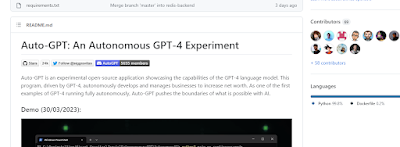Yes, An intriguing project that completely automates the work of GPT ☺
One of the most fascinating developments in recent years in the field of artificial intelligence has been the creation of huge language models. Natural language processing, content generation, and chatbots are just some of the many areas that can benefit from models like GPT-3 and GPT-4's ability to generate coherent, human-like writing. Some versions have several restrictions, especially when it comes to handling long- and short-term memory and connecting to the Internet.
The goal of the Auto-GPT experiment is to develop a fully autonomous system that can generate and manage tasks according to the GPT specification. The scientific community appears to be quite interested in this project, as seen by its rapid rise in GitHub popularity 👱 .
Auto-GPT relies heavily on its ability to operate with minimal human intervention. It takes a big language model and turns it into an autonomous agent that can take action and learn from its mistakes. Essentially, an enhanced auto-complete.
Auto-GPT can now generate its own programs with the help of #gpt4, as well as run Python scripts. Because of this, it is able to fix bugs in its own code, make improvements to itself, and get better over time. It has access to the internet for research and data collection, giving it a wealth of information.
Because it is free and open-source, anyone can join the Auto-GPT community on Github, give it a try, and even contribute to the project. In addition to Python 3.8 or later, the OpenAI API key, and the Pinecone API key are required to begin using Auto-GPT. The ability to have the AI talk is an optional feature that requires the use of an ElevenLabs Key 💨.
Auto-GPT is a promising open-source app, although it is currently in beta and has several limitations because of this. Complex, real-world business scenarios may be beyond its capabilities, but if successful, users are urged to publish their findings. Because of the high cost of operation, users of OpenAI should establish and track API key limitations.
The results of Auto-GPT demonstrate the power of the GPT-4 language model, making it an intriguing experiment overall. It demonstrates the potential of autonomous systems that can learn and grow on their own, and it pushes the limits of what is currently feasible in artificial intelligence. Although the present version has several restrictions,
When it comes to building smart machines, Auto-GPT is a giant leap ahead. It will be fascinating to observe how artificial intelligence is used and developed as technology develops further.
Don't forget to check these important links :
GitHub repository for Auto-GPT: https://github.com/Torantulino/Auto-GPT
OpenAI API: https://openai.com/api/
Pinecone API: https://www.pinecone.io/
Happy Chatting with GPT.


The Auto-GPT project is undeniably intriguing and represents a significant milestone in the field of artificial intelligence. The idea of developing a fully autonomous system that can generate and manage tasks based on the GPT specification is truly remarkable. The fact that Auto-GPT can learn from its mistakes, improve itself, and even fix bugs in its own code showcases the power of this technology.
ReplyDeleteThe project's open-source nature is commendable, as it allows anyone to join the community, try out the application, and contribute to its development. The integration of the OpenAI API and the Pinecone API, along with the optional feature of having the AI talk using ElevenLabs Key, further expands the capabilities of Auto-GPT.
Overall, Auto-GPT demonstrates the power of the GPT-4 language model and pushes the boundaries of what is currently achievable in artificial intelligence. It's a significant step forward in building autonomous systems that can learn and evolve independently. As technology continues to advance, it will be fascinating to witness the further development and applications of artificial intelligence.
Happy chatting with GPT and best wishes to the Auto-GPT project!